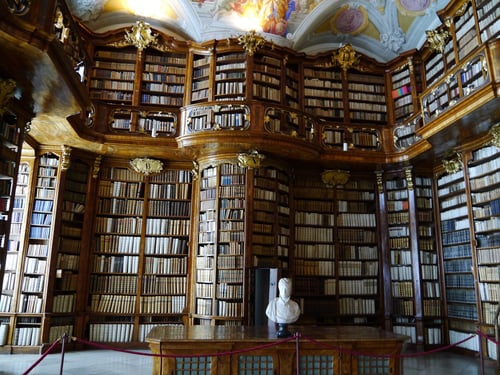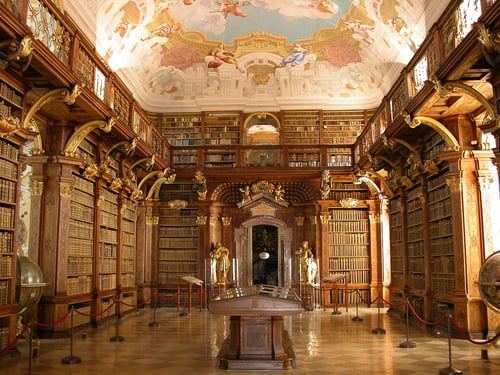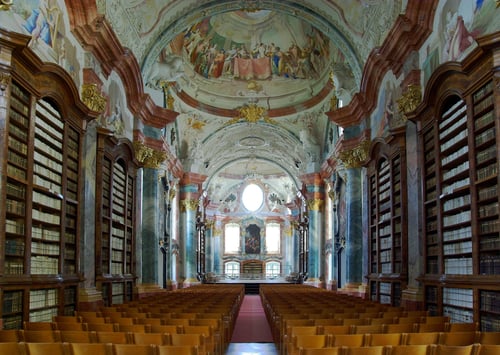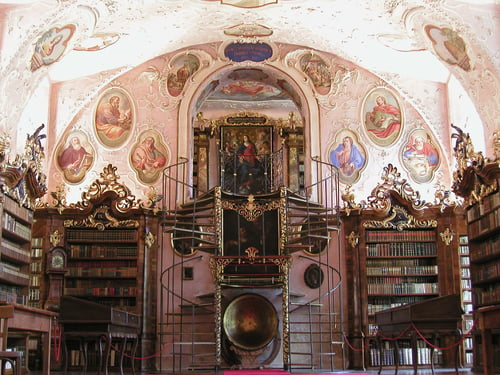Libraries provide an extraordinary window into the world. Indeed, for collectors and book enthusiasts, few pleasures equal a visit to a well-curated library. When planning a trip, it only makes sense to include famous (or not so famous) libraries on your itinerary.
Recently, a friend of Books Tell You Why and an avid book collector did just that. While traveling to Austria, he visited the libraries of five Austrian monasteries and was kind enough to detail his experiences for us to share. Whether you plan to visit Austria or simply enjoy great libraries, we are confident you will find his notes of interest.
Please note: This report does not profess to adhere to any scientific research or accuracy. It is a personal report based on notes, impressions, and memory. Enjoy!
Back from a trip visiting the libraries of five Austrian Monasteries, I am as excited as I have rarely been in my life. We experienced history in the form of manuscripts and printed books—dating from the eighth century to today—and were surrounded by architecture constructed of components of the same time period. The sense of being connected to a tangible part of history and to see the evolution of an art and a utility of critical importance to the development of Western Civilization is just extraordinary.
The Monasteries we visited were St. Florian, Melk, Altenburg, Vorau and Admont. The trip formed a circle south-west of Vienna, and totaled about 500km, some on well-maintained highways and some on smaller beautiful alpine roads. We clearly took too little time for the tour, but in the planning process of this trip, we only considered it as “exploratory.” In Melk alone, we realized that we probably could easily have spent two solid weeks!
St. Florian
St. Florian, an Augustine Abbey, was founded in the ninth century (first mention of the name by a scribe from Regensburg in 819). The current library was added to the building in 1744. The total number of books amounts to approximately 130,000. St. Florian has a great collection of manuscripts and manuscript pages of the times before 1200. Famous is also the “Giant Bible,” probably created around 1190 in Salzburg. The book is approximately 26’x18’, and comprises 358 leaves. The bible is somewhat incomplete but otherwise in incredible condition.
 |
| Library of St. Florian Abbey by Zairon, used under CC 3.0 license |
The library is accessible by appointment only and involves a presentation fee. Access to the books is limited, but the tour can be extended. We had the pleasure of being guided by the librarian who is extremely knowledgeable about the inventory, history, and condition of the books. It was a real pleasure to talk with him about all aspects of St. Florian, including the particularities that separate the library of this Augustine Abbey from the otherwise prevailing Benedictine Monasteries in the area.
Melk
Melk, a Benedictine Abbey, was clearly my favorite in the group—for a number of reasons. First, its history. Melk was a center of royal and imperial church property under the Carolingians and the Ottonians. One of the oldest Benedictine Monasteries, its library contains approximately 1800 manuscripts dating back to the 9th century.
The library also owns 750 Incunabula, 1,700 works of the 16th century, 4,500 of the 17th century, and 18,000 of the 18th century. The 19th century to today includes approximately 100,000 volumes, of which 16,000 are located in the library room. They include all categories from theology, law, geography, astronomy, history, and a vast collection of encyclopedia. I had the pleasure of holding in my hands, among others, the Herzog Albrecht Breviary dating back to 1450.
 |
| Melk Abbey Library |
One of the main relevant events for Melk was the creation of the Melk Reform in the early 1400s. The reform was due to the realization that the church had become “rich and lazy”. The new decree was “ora, labora et lege” which translates to pray, work and read. The Melk Reform created a strong literary character, hence the importance of the Melk library. Not just reading but also writing became a bigger part of the central activities for the monks. The Reform also mandated much stronger adherence to prayer, fasting, and hard work.
Altenburg
Altenburg, also a Benedictine Abbey, is first listed in an 1144 document that contains the approval of the building of a “Cella” on the current location. The current structure was completed in 1734. Today the Altenburg monastery is a multifaceted religious, cultural, and economic enterprise that includes activities such as foresting, fishery, biological farming, wine production and marketing, and biomass heating. It also offers accommodations for visitors and provides a good restaurant.
 |
| Altenburg Abbey by Christian Jansky, used under the CC 3.0 license |
The library has a spectacular layout with incredibly beautiful wall and ceiling paintings. The books are largely white in their bindings, and have mostly been rebound to meet the current standardized look.
The main library was completed in 1742 and has a length of 53 yards. It contains sections labeled as Klio (History), Apoll (Poetry), Moses (Theology), Minerva (Philosophy), Urania (Astronomy), Orpheus (Rhetoric), Archimedes (Geometry), and Euterpe (Music). Besides the Main Library, there is a second, smaller library (“Praelator Bibliothek”) which houses history and modern literature.
Altenburg also prides itself on having one of the earliest library catalogues known in the Western World, which dates back to the first half of the 7th century. Very important are also its large collection of books of antique (Priscian, Avianus, Ovid, Aristoteles etc.) and medieval literature by the likes of Petrus Hispanus (ł 1277) and Nikolaus von Lyra (ł 1349). The total number of books in both libraries and in cavernous storage is approximately 180,000 volumes.
Vorau
Vorau, an Augustine Monastery, was founded in 1163, but encountered a series of tragic events through the centuries. It was destroyed for the first time by a huge fire in 1237. Unfortunately, a large part of the library’s books and manuscripts were destroyed. The influence of Protestantism led, in 1542, to a two year vacancy of the monastery, and real reconstruction only started again in 1597.
 |
| Vorau Library by Roman Klementschitz, used under CC 3.0 license |
Another disastrous period for Vorau was the time of the “Anschluss” to the German Reich in 1940. The monastery became occupied by the German NS Regime, and all the clerical personnel were sent off the premises. During the final months of the Second World War, in April and May 1945, more than half of the buildings were completely destroyed during battles with Russian troops. In total, about 6,000 rare and valuable books were stolen, and many more were destroyed or seriously damaged. It took until 1963 to restore the buildings to today’s form, but very few of the stolen books have been recovered.
The Vorau Library is climate protected and therefore closed in winter, from the end of October to March. Since we visited the Abbey at the end of November, we were unfortunately not able to enter the library, but could view it from the outside.
Admont
Admont, a Benedictine Abbey, was founded in 1074 and is the oldest existing monastery in Styria. Due to its significant writing school, Admont became a cultural and spiritual center in the Middle Ages. In 1865, a fire destroyed almost the entire abbey, but due to the particular construction of the roof, the library was saved almost completely from the fire and only suffered minor water damage.
 |
| Admont Abbey Library by Jorge Royan, used under CC 3.0 license |
Admont claims to have the largest monastic library in the world. It holds some 70,000 volumes physically in the library, while the Abbey in total owns nearly 200,000 books. The most valuable among these are the more than 1,400 manuscripts (the oldest dating to the 8th century AD) and the 530 Incunabula. Individual books are accessible provided a prior specific request has been filed with the librarian. Understandably, a personal ID is also required.
Please note: All monastery library visits require a separate application, and all are subject to a special fee (which range from €25 to €70). In my view, they are all very much justified, and highly recommended, if one is interested in a serious discussion. We spent three hours in St. Florian, five hours at Melk, about two hours at Altenburg, one hour at Vorau (which basically was a more generic tour of the Abbey), and over three hours at Admont—all much too short a time allocated to the visits! You may see a map of the travel route below:
Are you interested in determining what famous library you should visit next? Take our quiz here! If you would like more information about today's post, please email us at info@bookstellyouwhy.com.









